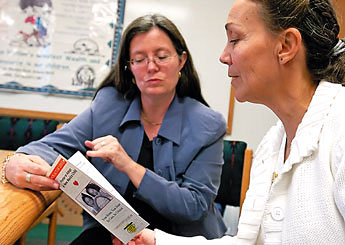|
Additional foster and adoptive parents needed in
McKinley, Cibola counties

Foster and Adoptive Parent recruiter Patricia Hale points out the
benefits of adopting a child to Erlinda Mulligan on Tuesday evening
at the Children, Youth and Families Department's open house in Gallup.
Mulligan and her husband have already raised six children of their
own and are considering becoming foster parents. [Photo by Matt
Hinshaw/Independent]
By Elizabeth Hardin-Burrola
Staff Writer
GALLUP — The New Mexico Children, Youth and Families
Department is currently sponsoring a statewide campaign to recruit
more foster and adoptive parents.
According to Patricia Hale, a foster and adoptive parent recruiter
for CYFD, the situation is particularly critical in McKinley and
Cibola counties. Hale is a recruiter for Region I, which covers
Cibola, McKinley, San Juan, Sandoval, Torrance, and Valencia counties.
Hale and local CYFD staff members recently sponsored two open houses
in McKinley and Cibola counties in an attempt to get more prospective
foster and adoptive families locally.
The next training session for foster or adoptive parents is scheduled
to begin in Gallup next weekend.
Close to home
"We are really needing foster families in Grants and Gallup,"
said Hale, who explained that about 45 to 50 children are in the
foster care system in McKinley County every month, with Cibola County
having an even higher number. Hale said CYFD works "very diligently"
to keep foster children in their home communities near family, friends,
and school but with the lack of local foster homes, the agency has
to place a number of children in foster homes across the state.
Seven prospective foster parents showed up for Tuesday's open house
in Gallup, said Hale. Five were interested in being foster parents
in Gallup, and two were residents of the Navajo Nation and were
looking to be foster parents for the Navajo Children and Family
Services Program. In cases involving Native American children, Hale
explained, where the child is taken into custody determines whether
the state or the tribe arranges the foster care.
Navajo families are particularly needed to foster Navajo children,
she added. Because of the Indian Child Welfare Act, social workers
are legally required to search for Native American foster and adoptive
parents as a priority for Native children. However, in this area,
the number of Native children in the foster care system exceeds
the number of Native American foster homes.
"It's all part of maintaining a cultural connection,"
Hale said. "If there's any way we can match a child to their
cultural background, we try."
Family ties
CYFD also tries to help children maintain their connection to their
family while in foster care, said Hale.
"The goal is reunification," she said.
Most foster children do return to their parents, Hale said, after
the family crisis is over and the biological parents have received
the help required by their social worker or the legal system. For
the small number of children whose parents have their parental rights
terminated, they become eligible for adoption. Statewide, said Hale,
there are over 200 children available for adoption, with most of
them being older than eight years old.
"A lot of our foster parents do end up adopting," she
said.
Adding more local foster parents would not only benefit children
in the community, explained Hale, but it would provide more support
to current local foster parents. In addition to foster parents who
offer regular day-to-day care, foster parents can sign up to just
provide short-term emergency foster care of one to 30 days, or respite
foster care of one to four days to give regular foster parents a
needed break.
According to Hale, the foster or adoptive parent training takes
about four months to complete and involves 27 hours of instruction,
a background check, and home study. After the process is completed,
foster parents are required to take an additional 10 hours of on-going
training each year.
Hale believes the process is "pretty thorough and intense."
However, that system doesn't always guarantee success. At the same
time the CYFD has been promoting foster care and adoption with the
theme "An Act of Love, Foster or Adopt a New Mexico Child,"
two recent deaths of children in the state one a foster child and
the other a disabled adopted child have left CYFD state officials
trying to understand and explain what went wrong with those particular
placements.
In contrast, Hale believes the many good foster parents assume their
responsibility "because their heart is there" with the
children they take into their homes.
According to Hale, many people don't apply to be foster parents
because they fear they will become too emotionally attached to the
children. Although it's challenging for foster parents to maintain
an emotional boundary, Hale believes a foster parent's care and
love can be a lifelong gift to an abused and neglected child.
The love that foster parents give children follows the children
throughout their lives and helps to make the children better people,
she said. Some foster children maintain a connection to their former
foster parents, she explained, and keep in touch through letters,
phone calls, and visits.
Being a caring foster parent also provides a healthy parenting example
for biological parents who are interested in becoming better parents
for their children, Hale added.
"They become a parent and mentor to that child and sometimes
to the biological parent," she said of good foster parents.
|
Weekend
February 24, 2007
Selected
Stories:
Foes debate risks
of uranium mining
Sandoval:
Accident 'traumatic'; Chief of Staff grieves after hitting, killing
pedestrian
Cell
number created to report drunk drivers; McKinley County near top
in DWI arrests and fatalities
Additional
foster and adoptive parents needed in McKinley, Cibola counties
Spiritual Perspectives;
Adoption is a Wonderful and Powerful Thing
Deaths
|



